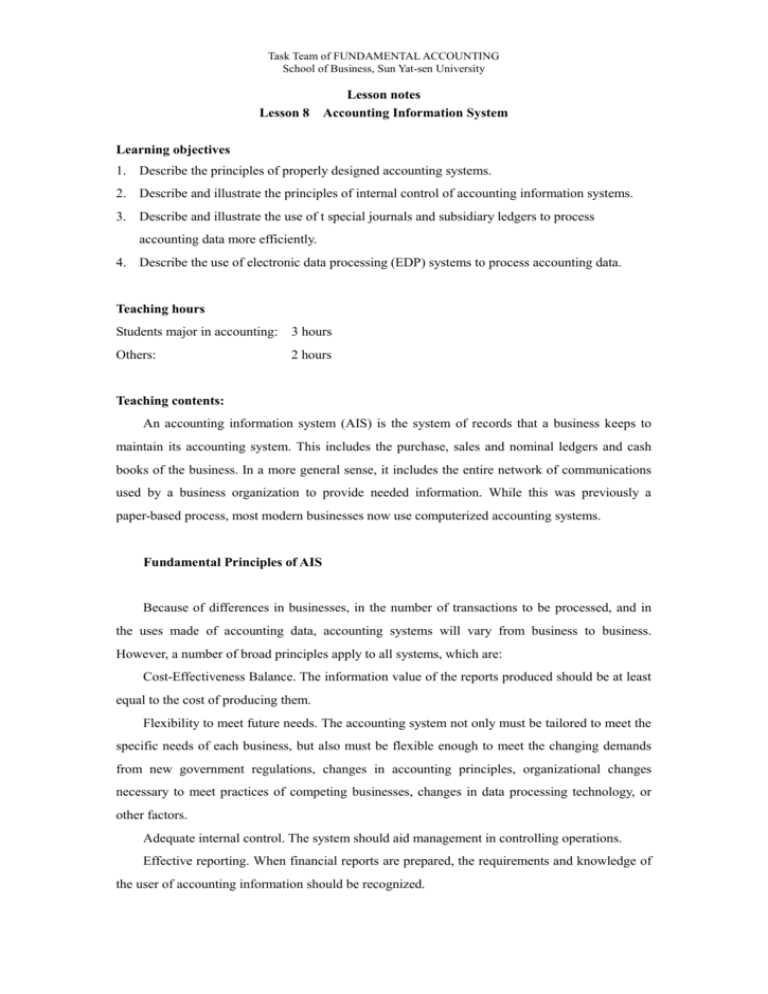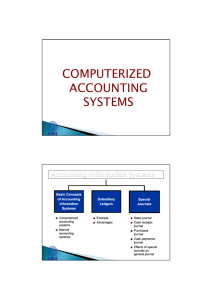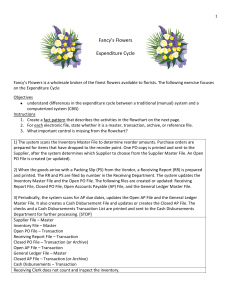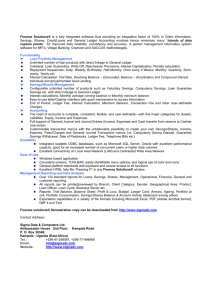Task Team of FUNDAMENTAL ACCOUNTING School of Business
advertisement

Task Team of FUNDAMENTAL ACCOUNTING School of Business, Sun Yat-sen University Lesson notes Lesson 8 Accounting Information System Learning objectives 1. Describe the principles of properly designed accounting systems. 2. Describe and illustrate the principles of internal control of accounting information systems. 3. Describe and illustrate the use of t special journals and subsidiary ledgers to process accounting data more efficiently. 4. Describe the use of electronic data processing (EDP) systems to process accounting data. Teaching hours Students major in accounting: 3 hours Others: 2 hours Teaching contents: An accounting information system (AIS) is the system of records that a business keeps to maintain its accounting system. This includes the purchase, sales and nominal ledgers and cash books of the business. In a more general sense, it includes the entire network of communications used by a business organization to provide needed information. While this was previously a paper-based process, most modern businesses now use computerized accounting systems. Fundamental Principles of AIS Because of differences in businesses, in the number of transactions to be processed, and in the uses made of accounting data, accounting systems will vary from business to business. However, a number of broad principles apply to all systems, which are: Cost-Effectiveness Balance. The information value of the reports produced should be at least equal to the cost of producing them. Flexibility to meet future needs. The accounting system not only must be tailored to meet the specific needs of each business, but also must be flexible enough to meet the changing demands from new government regulations, changes in accounting principles, organizational changes necessary to meet practices of competing businesses, changes in data processing technology, or other factors. Adequate internal control. The system should aid management in controlling operations. Effective reporting. When financial reports are prepared, the requirements and knowledge of the user of accounting information should be recognized. Task Team of FUNDAMENTAL ACCOUNTING School of Business, Sun Yat-sen University Adaptation to organization structure. The accounting system must be tailored to the organizational structure of each business Internal Controls of AIS The objectives of an accounting information system may differ from entity to entity, but most information systems have as an objective the provision of reliable information on a timely basis. Internal controls are a serial procedures that are designed to provide management with some degree of assurance that the information provided by the accounting information system is reliable and provided on a timely basis. These procedures include: Competent personnel and rotation of duties. It is necessary that all accounting employees be adequately trained and supervised to perform their jobs. It is also advisable to rotate clerical personal periodically from job to job. Assignment of responsibility. To motivate employees work efficiently, their responsibilities must be clearly defined. Separation of responsibility for related operation. To decrease the possibility of inefficiency, errors, and fraud, responsibility for a sequence of related operations should be divided among two or more persons. For example, no one individual should be authorized to order merchandise, verify the receipt of the goods, and pay the supplier. Separation of operation and accounting. Responsibility for maintaining the accounting records should be separated from the responsibility for engaging in business transactions and for the custody of the firm's assets. Proofs and security measures. Proofs and security measures should be used to safeguard business assets and assure reliable accounting data. Independent review. To determine whether the other internal control principles are being effectively applied, the system should be periodically reviewed and evaluated by internal auditors independent of the employees responsible for operations. The accounting process The accounting process is a series of activities that begins with a transaction and ends with the closing of the books. The major steps of the accounting process are as follows: Identify the transaction or other recognizable event; Prepare the transaction's source document such as a purchase order or invoice. Analyze and classify the transaction. Task Team of FUNDAMENTAL ACCOUNTING School of Business, Sun Yat-sen University Record the transaction by making entries in the appropriate journal, such as the sales journal, purchase journal, cash receipt or disbursement journal, or the general journal. Post general journal entries to the ledger accounts. The above steps are performed throughout the accounting period as transactions occur or in periodic batch processes. The following steps are performed at the end of the accounting period: Prepare the trial balance to make sure that debits equal credits. Correct any discrepancies in the trial balance. If the columns are not in balance, look for math errors, posting errors, and recording errors. Prepare adjusting entries to record accrued, deferred, and estimated amounts. Post adjusting entries to the ledger accounts. Prepare the adjusted trial balance. Prepare the financial statements. Components of an AIS An accounting system is comprised of accounting records and a series of processes and procedures assigned to staff, volunteers, and/or outside professionals. The goals of the accounting system are to ensure that financial data and economic transactions are properly entered into the accounting records and that financial reports necessary for management are prepared accurately and in a timely fashion. Traditionally, the accounting system includes the following components: Source documents The source document is the original record of a transaction. During an audit, source documents are used as evidence that a particular business transaction occurred. Examples of source documents include: Cash receipts Credit card receipts Cash register tapes Cancelled checks Customer invoices Supplier invoices Purchase orders Time cards Deposit slips Notes for loans Task Team of FUNDAMENTAL ACCOUNTING School of Business, Sun Yat-sen University Payment stubs for interest At a minimum, each source document should include the date, the amount, and a description of the transaction. When practical, beyond these minimum requirements source documents should contain the name and address of the other party of the transaction. When a source document does not exist, for example, when a cash receipt is not provided by a vendor or is misplaced, a document should be generated as soon as possible after the transaction, using other documents such as bank statements to support the information on the generated source document. Once a transaction has been journalized, the source document should be filed and made retrievable so that transactions can be verified should the need arise at a later date. Special journals Special journals are accounting records or devices designed to record a specific type of transaction in a highly efficient manner. Because a special journal is used only to record a specific type of transaction, the journal may be located at the transaction site and maintained by employees other than accounting personnel. Thus special journals reduce the time, effort, and cost of recording routine business transactions. Transactions Sales on credit Purchases on credit Cash receipts Cash Payments Special Journal (Abbrevviation) Sales Journal (S) Purchases Journal (P) Cash Receipts Journal (CR) Cash Payments Journal (CP) The sales journal is used only for recording sales of merchandise on account; sales of merchandise for cash are recorded in the cash receipts journal. Sales of non-merchandise assets are recorded in the cash receipts journal or the general journal, depending upon whether the sale was made for cash or on account. The purchase journal is designed to allow for the recording of everything purchased on account. Cash payments journal records all transactions in which cash is paid. Subsidiary Ledgers and General ledger Think of the accounting system as a wheel whose hub is the general ledger (G/L). Feeding the hub information are the spokes of the wheel. These include Accounts receivable Accounts payable Order entry Inventory control Cost accounting Payroll Fixed assets accounting Task Team of FUNDAMENTAL ACCOUNTING School of Business, Sun Yat-sen University These modules are ledgers themselves. We call them subledgers. Each contains the detailed entries of its specific field, such as accounts receivable. The subledgers summarize the entries, then send the summary up to the general ledger. For example, each day the receivables subledger records all credit sales and payments received. The transactions net together then go up to the G/L to increase or decrease A/R, increase cash and decrease inventory. General ledger is the principal ledger, which contains all of the balance sheet and income statement accounts. Each subsidiary ledger is represented in the general ledger by a summarizing account, called a controlling account. The balance in the controlling accounts must equal the sum of the balances in the subsidiary ledgers Computerized AIS A system that uses an electronic computer to process accounting data may be termed an electronic data processing (EDP) system or computerized accounting information system. An electronic data processing system processes accounting data in much the same way as does a manual system but with greater speed and accuracy. For example, electronic cash registers are being used with the computer to process both cash and credit sales. For cash sales, the data entered by the salesclerk in the electronic cash register provide the basis for the computer to update the accounting records, including the cash receipts journal and the general ledger accounts. For credit sales, the sales clerk enters the customer's account number and other relevant data in the electronic cash register. The computer then updates the customer's account in the subsidiary ledger and the other accounting records. Printouts of the updated general ledger and subsidiary account balances, the sales journal, and customers statements of account can be obtained when needed. In recent years, microcomputers and minicomputers have made electronic data processing affordable to small and medium-size businesses. Some small businesses have been able to gain the use of electronic data processing through computer service centers, which provide computer services on a fee-basis. Summary As the system of records that a business keeps to provide financial information, Accounting information system (AIS) has based its design on some fundamental principles. An accounting system is comprised of accounting records and a series of processes and procedures assigned to staff, volunteers, and/or outside professionals, which traditionally includes source documents, special journals, subsidiary journals and general journals. In recent years, because of the Task Team of FUNDAMENTAL ACCOUNTING School of Business, Sun Yat-sen University development of IT industry, manual-based accounting information system has been replaced by computerized AIS. Key points 1. The principles applying to all accounting information systems. 2. Comparing of manual accounting data processing methods and computerized data processing methods. Reading material 1. Philip E. Fess and Carl S. Warren, Accounting Principles, South-Western Publishing Co., 1987. 2. Burrowes, Ashley W. Core Concepts of Accounting Information Systems. Issues in Accounting Education, May2005, Vol. 20 Issue 2. 3. Sutton, Steve G., The role of AIS research in guiding practice.,International Journal of Accounting Information Systems, Mar2005, Vol. 6 Issue 1. 4. Hutchison, Paul D., White, Craig G., and Daigle, Ronald J., Advances in Accounting Information Systems and International Journal of Accounting Information Systems: first ten volumes (1992–2003)., International Journal of Accounting Information Systems, Oct2004, Vol. 5 Issue 3. 5. Lin, Fengyi, A Unified Accounting Information Framework To Modeling Bank Accounting Systems, Journal of Applied Business Research, Fall2004, Vol. 20 Issue 4.







